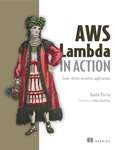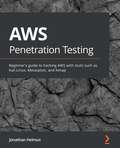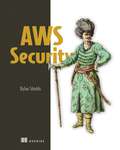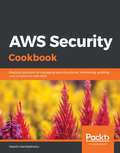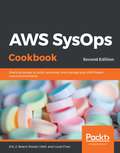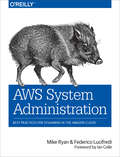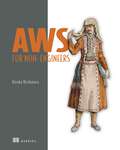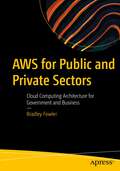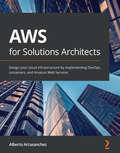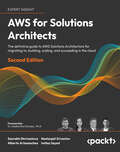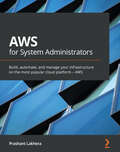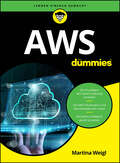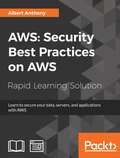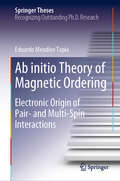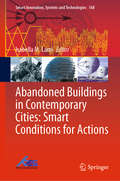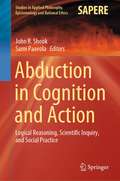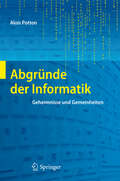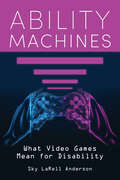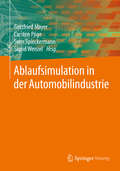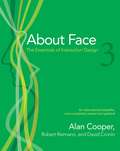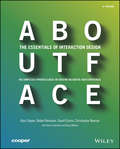- Table View
- List View
AWS Lambda in Action: Event-driven serverless applications
by Danilo PocciaSummaryAWS Lambda in Action is an example-driven tutorial that teaches you how to build applications that use an event-driven approach on the back end. Purchase of the print book includes a free eBook in PDF, Kindle, and ePub formats from Manning Publications.About the TechnologyWith AWS Lambda, you write your code and upload it to the AWS cloud. AWS Lambda responds to the events triggered by your application or your users, and automatically manages the underlying computer resources for you. Back-end tasks like analyzing a new document or processing requests from a mobile app are easy to implement. Your application is divided into small functions, leading naturally to a reactive architecture and the adoption of microservices.About the BookAWS Lambda in Action is an example-driven tutorial that teaches you how to build applications that use an event-driven approach on the back-end. Starting with an overview of AWS Lambda, the book moves on to show you common examples and patterns that you can use to call Lambda functions from a web page or a mobile app. The second part of the book puts these smaller examples together to build larger applications. By the end, you'll be ready to create applications that take advantage of the high availability, security, performance, and scalability of AWS.What's InsideCreate a simple APICreate an event-driven media-sharing applicationSecure access to your application in the cloudUse functions from different clients like web pages or mobile appsConnect your application with external servicesAbout the ReaderRequires basic knowledge of JavaScript. Some examples are also provided in Python. No AWS experience is assumed.About the AuthorDanilo Poccia is a technical evangelist at Amazon Web Services and a frequent speaker at public events and workshops.Table of ContentsPART 1 - FIRST STEPSRunning functions in the cloudYour first Lambda functionYour function as a web APIPART 2 - BUILDING EVENT-DRIVEN APPLICATIONSManaging securityUsing standalone functionsManaging identitiesCalling functions from a clientDesigning an authentication serviceImplementing an authentication serviceAdding more features to the authentication serviceBuilding a media-sharing applicationWhy event-driven?PART 3 - FROM DEVELOPMENT TO PRODUCTIONImproving development and testingAutomating deploymentAutomating infrastructure managementPART 4 - USING EXTERNAL SERVICESCalling external servicesReceiving events from other services
AWS Penetration Testing: Implement various security strategies on AWS using tools such as Kali Linux, Metasploit, and Nmap
by Jonathan HelmusGet to grips with security assessment, vulnerability exploitation, workload security, and encryption with this guide to ethical hacking and learn to secure your AWS environmentKey FeaturesPerform cybersecurity events such as red or blue team activities and functional testingGain an overview and understanding of AWS penetration testing and securityMake the most of your AWS cloud infrastructure by learning about AWS fundamentals and exploring pentesting best practicesBook DescriptionCloud security has always been treated as the highest priority by AWS while designing a robust cloud infrastructure. AWS has now extended its support to allow users and security experts to perform penetration tests on its environment. This has not only revealed a number of loopholes and brought vulnerable points in their existing system to the fore, but has also opened up opportunities for organizations to build a secure cloud environment. This book teaches you how to perform penetration tests in a controlled AWS environment.You'll begin by performing security assessments of major AWS resources such as Amazon EC2 instances, Amazon S3, Amazon API Gateway, and AWS Lambda. Throughout the course of this book, you'll also learn about specific tests such as exploiting applications, compromising Identity and Access Management (IAM) keys, testing permissions flaws, and discovering weak policies. Moving on, you'll discover how to establish private-cloud access through backdoor Lambda functions. As you advance, you'll explore the no-go areas where users can't make changes due to vendor restrictions, and find out how you can avoid being flagged to AWS in these cases. Finally, this book will take you through tips and tricks for securing your cloud environment in a professional way.By the end of this penetration testing book, you'll have become well-versed in a variety of ethical hacking techniques for securing your AWS environment against modern cyber threats.What you will learnSet up your AWS account and get well-versed in various pentesting servicesDelve into a variety of cloud pentesting tools and methodologiesDiscover how to exploit vulnerabilities in both AWS and applicationsUnderstand the legality of pentesting and learn how to stay in scopeExplore cloud pentesting best practices, tips, and tricksBecome competent at using tools such as Kali Linux, Metasploit, and NmapGet to grips with post-exploitation procedures and find out how to write pentesting reportsWho this book is forIf you are a network engineer, system administrator, or system operator looking to secure your AWS environment against external cyberattacks, then this book is for you. Ethical hackers, penetration testers, and security consultants who want to enhance their cloud security skills will also find this book useful. No prior experience in penetration testing is required; however, some understanding in cloud computing or AWS cloud is recommended.
AWS Security
by Dylan ShieldsRunning your systems in the cloud doesn&’t automatically make them secure. Learn the tools and new management approaches you need to create secure apps and infrastructure on AWS.In AWS Security you&’ll learn how to: Securely grant access to AWS resources to coworkers and customers Develop policies for ensuring proper access controls Lock-down network controls using VPCs Record audit logs and use them to identify attacks Track and assess the security of an AWS account Counter common attacks and vulnerabilities Written by security engineer Dylan Shields, AWS Security provides comprehensive coverage on the key tools and concepts you can use to defend AWS-based systems. You&’ll learn how to honestly assess your existing security protocols, protect against the most common attacks on cloud applications, and apply best practices to configuring identity and access management and virtual private clouds. About the technology AWS provides a suite of strong security services, but it&’s up to you to configure them correctly for your applications and data. Cloud platforms require you to learn new techniques for identity management, authentication, monitoring, and other key security practices. This book gives you everything you&’ll need to defend your AWS-based applications from the most common threats facing your business. About the book AWS Security is the guide to AWS security services you&’ll want on hand when you&’re facing any cloud security problem. Because it&’s organized around the most important security tasks, you&’ll quickly find best practices for data protection, auditing, incident response, and more. As you go, you&’ll explore several insecure applications, deconstruct the exploits used to attack them, and learn how to react with confidence. What's inside Develop policies for proper access control Securely assign access to AWS resources Lock-down network controls using VPCs Record audit logs and use them to identify attacks Track and assess the security of an AWS account About the reader For software and security engineers building and securing AWS applications. About the author Dylan Shields is a software engineer working on Quantum Computing at Amazon. Dylan was one of the first engineers on the AWS Security Hub team. Table of Contents 1 Introduction to AWS security 2 Identity and access management 3 Managing accounts 4 Policies and procedures for secure access 5 Securing the network: The virtual private cloud 6 Network access protection beyond the VPC 7 Protecting data in the cloud 8 Logging and audit trails 9 Continuous monitoring 10 Incident response and remediation 11 Securing a real-world application
AWS Security Cookbook: Practical solutions for managing security policies, monitoring, auditing, and compliance with AWS
by Heartin KanikathottuSecure your Amazon Web Services (AWS) infrastructure with permission policies, key management, and network security, along with following cloud security best practices Key Features Explore useful recipes for implementing robust cloud security solutions on AWS Monitor your AWS infrastructure and workloads using CloudWatch, CloudTrail, config, GuardDuty, and Macie Prepare for the AWS Certified Security-Specialty exam by exploring various security models and compliance offerings Book Description As a security consultant, securing your infrastructure by implementing policies and following best practices is critical. This cookbook discusses practical solutions to the most common problems related to safeguarding infrastructure, covering services and features within AWS that can help you implement security models such as the CIA triad (confidentiality, integrity, and availability), and the AAA triad (authentication, authorization, and availability), along with non-repudiation. The book begins with IAM and S3 policies and later gets you up to speed with data security, application security, monitoring, and compliance. This includes everything from using firewalls and load balancers to secure endpoints, to leveraging Cognito for managing users and authentication. Over the course of this book, you'll learn to use AWS security services such as Config for monitoring, as well as maintain compliance with GuardDuty, Macie, and Inspector. Finally, the book covers cloud security best practices and demonstrates how you can integrate additional security services such as Glacier Vault Lock and Security Hub to further strengthen your infrastructure. By the end of this book, you'll be well versed in the techniques required for securing AWS deployments, along with having the knowledge to prepare for the AWS Certified Security – Specialty certification. What you will learn Create and manage users, groups, roles, and policies across accounts Use AWS Managed Services for logging, monitoring, and auditing Check compliance with AWS Managed Services that use machine learning Provide security and availability for EC2 instances and applications Secure data using symmetric and asymmetric encryption Manage user pools and identity pools with federated login Who this book is for If you are an IT security professional, cloud security architect, or a cloud application developer working on security-related roles and are interested in using AWS infrastructure for secure application deployments, then this Amazon Web Services book is for you. You will also find this book useful if you're looking to achieve AWS certification. Prior knowledge of AWS and cloud computing is required to get the most out of this book.
AWS SysOps Cookbook: Practical recipes to build, automate, and manage your AWS-based cloud environments, 2nd Edition
by Lucas Chan Rowan Udell Eric Z. BeardBecome an AWS SysOps administrator and explore best practices to maintain a well-architected, resilient, and secure AWS environment Key Features Explore AWS Cloud functionalities through a recipe-based approach Get to grips with a variety of techniques for automating your infrastructure Discover industry-proven best practices for architecting reliable and efficient workloads Book Description AWS is an on-demand remote computing service providing cloud infrastructure over the internet with storage, bandwidth, and customized support for APIs. This updated second edition will help you implement these services and efficiently administer your AWS environment. You will start with the AWS fundamentals and then understand how to manage multiple accounts before setting up consolidated billing. The book will assist you in setting up reliable and fast hosting for static websites, sharing data between running instances and backing up data for compliance. By understanding how to use compute service, you will also discover how to achieve quick and consistent instance provisioning. You'll then learn to provision storage volumes and autoscale an app server. Next, you'll explore serverless development with AWS Lambda, and gain insights into using networking and database services such as Amazon Neptune. The later chapters will focus on management tools like AWS CloudFormation, and how to secure your cloud resources and estimate costs for your infrastructure. Finally, you'll use the AWS well-architected framework to conduct a technology baseline review self-assessment and identify critical areas for improvement in the management and operation of your cloud-based workloads. By the end of this book, you'll have the skills to effectively administer your AWS environment. What you will learn Secure your account by creating IAM users and avoiding the use of the root login Simplify the creation of a multi-account landing zone using AWS Control Tower Master Amazon S3 for unlimited, cost-efficient storage of data Explore a variety of compute resources on the AWS Cloud, such as EC2 and AWS Lambda Configure secure networks using Amazon VPC, access control lists, and security groups Estimate your monthly bill by using cost estimation tools Learn to host a website with Amazon Route 53, Amazon CloudFront, and S3 Who this book is for If you are an administrator, DevOps engineer, or an IT professional interested in exploring administrative tasks on the AWS Cloud, then this book is for you. Familiarity with cloud computing platforms and some understanding of virtualization, networking, and other administration-related tasks is assumed.
AWS System Administration: Best Practices for Sysadmins in the Amazon Cloud
by Mike Ryan Federico LucifrediWith platforms designed for rapid adaptation and failure recovery such as Amazon Web Services, cloud computing is more like programming than traditional system administration. Tools for automatic scaling and instance replacement allow even small DevOps teams to manage massively scalable application infrastructures—if team members drop their old views of development and operations and start mastering automation.This comprehensive guide shows developers and system administrators how to configure and manage AWS services including EC2, CloudFormation, Elastic Load Balancing, S3, and Route 53. Sysadms will learn will learn to automate their favorite tools and processes; developers will pick up enough ops knowledge to build a robust and resilient AWS application infrastructure.Launch instances with EC2 or CloudFormationSecurely deploy and manage your applications with AWS toolsLearn to automate AWS configuration management with Python and PuppetDeploy applications with Auto Scaling and Elastic Load BalancingExplore approaches for deploying application and infrastructure updatesSave time on development and operations with reusable componentsLearn strategies for managing log files in AWS environmentsConfigure a cloud-aware DNS service with Route 53Use AWS CloudWatch to monitor your infrastructure and applications
AWS for Non-Engineers
by Hiroko NishimuraThis friendly, fast-paced guide is perfect for anyone puzzled by the cloud! Learn the fundamentals of Amazon Web Services, and be ready to ace your AWS Certified Cloud Practitioner Exam.In AWS for Non-engineers you will learn: How cloud computing and AWS are different from &“legacy&” systems Prepare for the AWS Certified Cloud Practitioner Exam When cloud computing is the right option for your organization Core AWS services including storage services, database services, and security services How billing and pricing work on AWS, and how to pick for your budget Security and compliance concepts for building in AWS AWS for Non-engineers is for anyone just starting with Amazon Web Services or cloud computing in general—whether you&’re in customer service, marketing, or management. It&’s written by Hiroko Nishimura, and is based on her acclaimed video courses that have been taken by over 300,000 learners. In this reader-friendly book, you&’ll learn how to talk about cloud concepts with engineers, what the cloud could do for your business, and how to start using AWS&’s amazing services for your own IT tasks. When you&’re finished, you&’ll be comfortable with the basics of cloud computing on AWS and you&’ll be prepared to take the AWS Certified Cloud Practitioner Exam! About the technology Millions of companies use Amazon Web Services (AWS) to share documents, run business applications, and store important data. Learning the basics of AWS is a required skill, and this book makes it easy! There&’s no geeky jargon nor complex code—just crystal-clear explanations of the AWS features you&’ll use every day. You&’ll even get tips on how to pass the entry-level AWS Certified Cloud Practitioner Exam! About the book AWS for Non-engineers is an absolute beginner&’s guide to Amazon Web Services, the leading cloud computing platform. In this short, practical guide, you&’ll find a beginner-friendly introduction to cloud computing concepts and how the cloud can be used. Learn how to log in to AWS, get to the apps and files you need, and safely share documents and data. You&’ll even get the vocabulary you need to talk about AWS with developers and administrators. What's inside Core AWS services for files, databases, and security How billing and pricing work on AWS Security and compliance concepts Pass the AWS Certified Cloud Practitioner Exam About the reader For absolute beginners to the cloud! No IT experience required. About the author Hiroko Nishimura created the popular &“Introduction to AWS for Non-Engineers&” LinkedIn Learning video course. She is an AWS Community Hero for her work in making AWS more accessible to people from diverse backgrounds. Table of Contents 1 Introduction to cloud computing and Amazon Web Services 2 Introduction to cloud concepts 3 Deploying and operating in AWS global infrastructure 4 Core AWS services 5 Security and compliance 6 Billing and pricing 7 AWS Certified Cloud Practitioner exam (CLF-C01)
AWS for Public and Private Sectors: Cloud Computing Architecture for Government and Business
by Bradley FowlerAssess, plan, develop, implement, and manage AWS EC2 Instances, Cloud Formation using JSON Template with Bash programming language, and Cloud Watch monitoring. This book helps the public and private sectors comprehend how to assess and evaluate AWS cloud software as a service (SaaS), infrastructure as a service (IaaS), and platform as a service (PaaS).Government and business sector entities are looking for strategies to upgrade on-premises information systems to virtual cloud infrastructure orchestration and automation. You'll gain a step-by-step approach to planning, developing, implementing, and managing cloud infrastructure, services, and platforms that help reduce cost increases, scalability, and improves security. Outline your strategy to research how cloud infrastructure is planned and developed before being deployed and managed by on-premises IT team members. This book also supports cloud services for AWS and helps you understand why supporting and using AWS for cloud services is beneficial both short and long-term.Once you complete this book, you'll be able to make logical decisions regarding AWS use cases for public and private sector entities, including disaster recovery and backup, IT self-service, Web applications, and messaging. What You'll LearnAssess different cloud services provided by AmazonLook at Cloud as a Service (CAAS)Understand internet protocol, packet switching, authoritative, recursive, and open-flowReview cloud infrastructure planning methodsExamine Cloud orchestration and automationWork with the AWS total cost of ownership calculatorWho This book Is ForThis book is aimed at business, government, non-profit organizations, academic institutions, and financial institutions interested in upgrading to AWS cloud architect infrastructure as a primary mode of data transmission, storage, and security at a scalable and economical annual cost.
AWS for Solutions Architects: Design your cloud infrastructure by implementing DevOps, containers, and Amazon Web Services
by Alberto ArtasanchezApply cloud design patterns to overcome real-world challenges by building scalable, secure, highly available, and cost-effective solutionsKey FeaturesApply AWS Well-Architected Framework concepts to common real-world use casesUnderstand how to select AWS patterns and architectures that are best suited to your needsEnsure the security and stability of a solution without impacting cost or performanceBook DescriptionOne of the most popular cloud platforms in the world, Amazon Web Services (AWS) offers hundreds of services with thousands of features to help you build scalable cloud solutions; however, it can be overwhelming to navigate the vast number of services and decide which ones best suit your requirements. Whether you are an application architect, enterprise architect, developer, or operations engineer, this book will take you through AWS architectural patterns and guide you in selecting the most appropriate services for your projects. AWS for Solutions Architects is a comprehensive guide that covers the essential concepts that you need to know for designing well-architected AWS solutions that solve the challenges organizations face daily. You'll get to grips with AWS architectural principles and patterns by implementing best practices and recommended techniques for real-world use cases. The book will show you how to enhance operational efficiency, security, reliability, performance, and cost-effectiveness using real-world examples. By the end of this AWS book, you'll have gained a clear understanding of how to design AWS architectures using the most appropriate services to meet your organization's technological and business requirements.What you will learnRationalize the selection of AWS as the right cloud provider for your organizationChoose the most appropriate service from AWS for a particular use case or projectImplement change and operations managementFind out the right resource type and size to balance performance and efficiencyDiscover how to mitigate risk and enforce security, authentication, and authorizationIdentify common business scenarios and select the right reference architectures for themWho this book is forThis book is for application and enterprise architects, developers, and operations engineers who want to become well-versed with AWS architectural patterns, best practices, and advanced techniques to build scalable, secure, highly available, and cost-effective solutions in the cloud. Although existing AWS users will find this book most useful, it will also help potential users understand how leveraging AWS can benefit their organization.
AWS for Solutions Architects: The definitive guide to AWS Solutions Architecture for migrating to, building, scaling, and succeeding in the cloud
by Alberto Artasanchez Saurabh Shrivastava Neelanjali Srivastav Imtiaz SayedBecome a master Solutions Architect with this comprehensive guide, featuring cloud design patterns and real-world solutions for building scalable, secure, and highly available systems Purchase of the print or Kindle book includes a free eBook in PDF format.Key FeaturesComprehensive guide to automating, networking, migrating, and adopting cloud technologies using AWSExtensive insights into AWS technologies, including AI/ML, IoT, big data, blockchain, and quantum computing to transform your business.Detailed coverage of AWS solutions architecture and the latest AWS certification requirementsBook DescriptionThe second edition of AWS for Solutions Architects provides a practical guide to designing cloud solutions that align with industry best practices. This updated edition covers the AWS Well-Architected Framework, core design principles, and cloud-native patterns to help you build secure, high-performance, and cost-effective architectures. Gain a deep understanding of AWS networking, hybrid cloud connectivity, and edge deployments. Explore big data processing with EMR, Glue, Kinesis, and MSK, enabling you to extract valuable insights from data efficiently. New chapters introduce CloudOps, machine learning, IoT, and blockchain, equipping you with the knowledge to develop modern cloud solutions. Learn how to optimize AWS storage, implement containerization strategies, and design scalable data lakes. Whether working on simple configurations or complex enterprise architectures, this guide provides the expertise needed to solve real-world cloud challenges and build reliable, high-performing AWS solutions.What you will learnOptimize your Cloud Workload using the AWS Well-Architected FrameworkLearn methods to migrate your workload using the AWS Cloud Adoption FrameworkApply cloud automation at various layers of application workload to increase efficiencyBuild a landing zone in AWS and hybrid cloud setups with deep networking techniquesSelect reference architectures for business scenarios, like data lakes, containers, and serverless appsApply emerging technologies in your architecture, including AI/ML, IoT and blockchainWho this book is forThis book is for application and enterprise architects, developers, and operations engineers who want to become well versed with AWS architectural patterns, best practices, and advanced techniques to build scalable, secure, highly available, highly tolerant, and cost-effective solutions in the cloud. Existing AWS users are bound to learn the most, but it will also help those curious about how leveraging AWS can benefit their organization. Prior knowledge of any computing language is not needed, and there’s little to no code. Prior experience in software architecture design will prove helpful.
AWS for Solutions Architects: The definitive guide to AWS Solutions Architecture for migrating to, building, scaling, and succeeding in the cloud, 2nd Edition
by Saurabh Shrivastava Neelanjali Srivastav Alberto Artasanchez Imtiaz Sayed Dr. Siddhartha Ph.DBecome a master Solutions Architect with this comprehensive guide, featuring cloud design patterns and real-world solutions for building scalable, secure, and highly available systemsPurchase of the print or Kindle book includes a free eBook in PDF format.Key FeaturesGain expertise in automating, networking, migrating, and adopting cloud technologies using AWSUse streaming analytics, big data, AI/ML, IoT, quantum computing, and blockchain to transform your businessUpskill yourself as an AWS solutions architect and explore details of the new AWS certificationBook DescriptionAre you excited to harness the power of AWS and unlock endless possibilities for your business? Look no further than the second edition of AWS for Solutions Architects! Packed with all-new content, this book is a must-have guide for anyone looking to build scalable cloud solutions and drive digital transformation using AWS. This updated edition offers in-depth guidance for building cloud solutions using AWS. It provides detailed information on AWS well-architected design pillars and cloud-native design patterns. You'll learn about networking in AWS, big data and streaming data processing, CloudOps, and emerging technologies such as machine learning, IoT, and blockchain. Additionally, the book includes new sections on storage in AWS, containers with ECS and EKS, and data lake patterns, providing you with valuable insights into designing industry-standard AWS architectures that meet your organization's technological and business requirements. Whether you're an experienced solutions architect or just getting started with AWS, this book has everything you need to confidently build cloud-native workloads and enterprise solutions.What you will learnOptimize your Cloud Workload using the AWS Well-Architected FrameworkLearn methods to migrate your workload using the AWS Cloud Adoption FrameworkApply cloud automation at various layers of application workload to increase efficiencyBuild a landing zone in AWS and hybrid cloud setups with deep networking techniquesSelect reference architectures for business scenarios, like data lakes, containers, and serverless appsApply emerging technologies in your architecture, including AI/ML, IoT and blockchainWho this book is forThis book is for application and enterprise architects, developers, and operations engineers who want to become well versed with AWS architectural patterns, best practices, and advanced techniques to build scalable, secure, highly available, highly tolerant, and cost-effective solutions in the cloud. Existing AWS users are bound to learn the most, but it will also help those curious about how leveraging AWS can benefit their organization.Prior knowledge of any computing language is not needed, and there's little to no code. Prior experience in software architecture design will prove helpful.
AWS for System Administrators: Build, automate, and manage your infrastructure on the most popular cloud platform – AWS
by Prashant LakheraTake your AWS skills to the next level by learning infrastructure automation techniques using CloudFormation, Terraform, and Boto3Key FeaturesExplore AWS automation using CloudFormation, Terraform, and Boto3Leverage AWS to make your infrastructure flexible and highly availableDiscover various AWS features for building a secure and reliable environment to host your applicationBook DescriptionAmazon Web Services (AWS) is one of the most popular and efficient cloud platforms for administering and deploying your applications to make them resilient and robust. AWS for System Administrators will help you to learn several advanced cloud administration concepts for deploying, managing, and operating highly available systems on AWS. Starting with the fundamentals of identity and access management (IAM) for securing your environment, this book will gradually take you through AWS networking and monitoring tools. As you make your way through the chapters, you'll get to grips with VPC, EC2, load balancer, Auto Scaling, RDS database, and data management. The book will also show you how to initiate AWS automated backups and store and keep track of log files. Later, you'll work with AWS APIs and understand how to use them along with CloudFormation, Python Boto3 Script, and Terraform to automate infrastructure. By the end of this AWS book, you'll be ready to build your two-tier startup with all the necessary infrastructure, monitoring, and logging components in place.What you will learnAdopt a security-first approach by giving users minimum access using IAM policiesBuild your first Amazon Elastic Compute Cloud (EC2) instance using the AWS CLI, Boto3, and TerraformSet up your datacenter in AWS Cloud using VPCScale your application based on demand using Auto ScalingMonitor services using CloudWatch and SNSWork with centralized logs for analysis (CloudWatch Logs)Back up your data using Amazon Simple Storage Service (Amazon S3), Data Lifecycle Manager, and AWS BackupWho this book is forThis Amazon Web Services book is for system administrators and solution architects who want to build highly available and flexible AWS Cloud platforms for their applications. Software engineers and programmers looking to deploy their applications to AWS Cloud will also find this book useful. Basic knowledge of Linux and AWS is necessary to get started.
AWS for System Administrators: Build, automate, and manage your infrastructure on the most popular cloud platform – AWS
by Prashant LakheraTake your AWS SysOps skills to the next level by learning infrastructure automation techniques using CloudFormation, Terraform, and Boto3Key FeaturesBook DescriptionAmazon Web Services (AWS) is one of the most popular and efficient cloud platforms for administering and deploying your applications to make them resilient and robust. AWS for System Administrators will help you to learn several advanced cloud administration concepts for deploying, managing, and operating highly available systems on AWS. Starting with the fundamentals of identity and access management (IAM) for securing your environment, this book will gradually take you through AWS networking and monitoring tools. As you make your way through the chapters, you’ll get to grips with VPC, EC2, load balancer, Auto Scaling, RDS database, and data management. The book will also show you how to initiate AWS automated backups and store and keep track of log files. Later, you’ll work with AWS APIs and understand how to use them along with CloudFormation, Python Boto3 Script, and Terraform to automate infrastructure. By the end of this AWS book, you’ll be ready to build your two-tier startup with all the necessary infrastructure, monitoring, and logging components in place.What you will learnAdopt a security-first approach by giving users minimum access using IAM policiesBuild your first Amazon Elastic Compute Cloud (EC2) instance using the AWS CLI, Boto3, and TerraformSet up your datacenter in AWS Cloud using VPCScale your application based on demand using Auto ScalingMonitor services using CloudWatch and SNSWork with centralized logs for analysis (CloudWatch Logs)Back up your data using Amazon Simple Storage Service (Amazon S3), Data Lifecycle Manager, and AWS BackupWho this book is forThis Amazon Web Services book is for system administrators and solution architects who want to build highly available and flexible AWS Cloud platforms for their applications. Software engineers and programmers looking to deploy their applications to AWS Cloud will also find this book useful. Basic knowledge of Linux and AWS is necessary to get started.
AWS für Dummies (Für Dummies)
by Martina WeiglDer einfache Einstieg in AWS/Cloud Computing Dieses Buch ermöglicht Ihnen den Einstieg in AWS, die Amazon Web Services, und beschreibt verständlich die grundlegenden Dienste und fortgeschrittenen Funktionen. Martina Weigl erklärt Ihnen die unterschiedlichen Cloud-Betriebsmodelle und stellt die wichtigsten AWS-Produkte vor. Sie lernen, wie Sie die richtigen Dienste für Ihre Zwecke und Ihr Budget auswählen und wie Sie eigene AWS-Umgebungen aufbauen. Außerdem erfahren Sie anhand praktischer Beispiele, wie Sie die neuesten Entwicklungen im Bereich Künstlicher Intelligenz in der AWS-Cloud nutzen. Sie erfahren Wie Cloud Computing mit AWS funktioniert Wie Sie Cloud-Dienste sicher, kosteneffizient und performant nutzen Wie Sie KI einfach in Ihre Anwendungen einbauen können
AWS: Learn to secure your data, servers, and applications with AWS
by Albert AnthonyDelve deep into various security aspects of AWS to build and maintain a secured environmentKey Features●Learn to secure your network, infrastructure, data, and applications in AWS cloud●Use AWS managed security services to automate security●Dive deep into various aspects such as the security model, compliance, access management and much more to build and maintain a secured environment●Explore Cloud Adoption Framework (CAF) and its components●Embedded with assessments that will help you revise the concepts you have learned in this bookBook DescriptionWith organizations moving their workloads, applications, and infrastructure to the cloud at an unprecedented pace, security of all these resources has been a paradigm shift for all those who are responsible for security; experts, novices, and apprentices alike.This book focuses on using native AWS security features and managed AWS services to help you achieve continuous security. Starting with an introduction to Virtual Private Cloud (VPC) to secure your AWS VPC, you will quickly explore various components that make up VPC such as subnets, security groups, various gateways, and many more.You will also learn to protect data in the AWS platform for various AWS services by encrypting and decrypting data in AWS. You will also learn to secure web and mobile applications in AWS cloud.This book is ideal for all IT professionals, system administrators, security analysts, solution architects, and chief information security officers who are responsible for securing workloads in AWS for their organizations.This book is embedded with useful assessments that will help you revise the concepts you have learned in this book.What you will learn●Get familiar with VPC components, features, and benefits●Learn to create and secure your private network in AWS●Explore encryption and decryption fundamentals●Understand monitoring, logging, and auditing in AWS●Ensure data security in AWS●Secure your web and mobile applications in AWS●Learn security best practices for IAM, VPC, shared security responsibility model, and so onWho this book is forThis book is for all IT professionals, system administrators, security analysts, solution architects, and chief information security officers who are responsible for securing workloads in AWS for their organizations.
Aaron Marks' Complete Guide to Game Audio: For Composers, Sound Designers, Musicians, and Game Developers
by Aaron MarksWhether trying to land that first big gig or working to perfect the necessary skills to fill a game world with sound, Aaron Marks’ Complete Guide to Game Audio 3rd edition will teach the reader everything they need to know about the audio side of the multi-million dollar video game industry. This book builds upon the success of the second edition with even more expert advice from masters in the field and notes current changes within the growing video game industry. The tools of the trade excerpts will showcase what professionals, like Marty O’Donnell, Richard Jacques and Tom Salta, use to create their work and to help newcomers in the field prepare their own sound studios. Sample contracts are reviewed within the text as well as helpful advice about contractual terms and negotiable points. These sample contracts can also be found as a downloadable zip for the reader’s convenience. Aaron Marks also explores how to set your financial terms and network efficiently along with examples of how projects can go completely awry and achieving the best results in often complicated situations. Aaron Marks’ Complete Guide to Game Audio serves as the ultimate survival guide to navigating an audio career in the video game industry. Key Features New, full color edition with a complete update of information. Added and expanded coverage of field recording for games, creating voiceovers, adaptive and interactive audio and other cutting edge sound creation and implementation techniques used within games. Update/Replacement of interviews. Include interviews/features on international game audio professionals New and expanded interview features from game composers and sound designers of every experience level such as Keith Arem, Bradley Meyer, Christopher Tin and Rodney Gates including many international professionals like Pasi Pitkanen, Henning Nugel and Christos Panayides. Expanded and updated game console coverage of the Wii, Wii U, Xbox 360, Xbox One, PS3 and PS4. Includes new scripting and middleware concepts and techniques and review of powerful tools such as FMOD and Wwise.
Ab initio Theory of Magnetic Ordering: Electronic Origin of Pair- and Multi-Spin Interactions (Springer Theses)
by Eduardo Mendive TapiaMany technological applications exploit a variety of magnetic structures, or magnetic phases, to produce and optimise solid-state functionality. However, most research advances are restricted to a reduced number of phases owing to computational and resource constraints. This thesis presents an ab-initio theory to efficiently describe complex magnetic phases and their temperature-dependent properties. The central assumption is that magnetic phases evolve slowly compared with the underlying electronic structure from which they emerge. By describing how the electronic structure adapts to the type and extent of magnetic order, a theory able to describe multi-spin correlations and their effect on the magnetism at finite temperature is obtained. It is shown that multi-spin correlations are behind the temperature and magnetic field dependence of the diverse magnetism in the heavy rare earth elements. Magnetically frustrated Mn-based materials and the effect of strain are also investigated. These studies demonstrate that the performance of solid-state refrigeration can be enhanced by multi-spin effects.
Abandoned Buildings in Contemporary Cities: Smart Conditions for Actions (Smart Innovation, Systems and Technologies #168)
by Isabella M. LamiIs it possible to energise the reuse of urban abandoned spaces with low financial capital investment? Addressing this question requires a normative and cultural change, where the rules are less focused on the material processes of producing space and more aimed at fostering the construction of relationships. The reality of several European cities shows how traditional forms of stimulating urban renewal – with respect to the financing of operations, how to design and build, and urban planning legislation – no longer work. This book examines an alternative culture of design and regulation, drawing on the richness of the various approaches to the subject to present an integrated study of the phenomenon of reuse across its economic, architectural and urban dimensions. From this theoretical base, it empirically analyses six Italian case studies in terms of the broadness of geography and in their governance models, and of the important role of the unity of cultural destination for their reuse proposal. The book is intended for all those involved in the cultural challenge of reusing urban abandoned spaces, including public administrators, entrepreneurs, architects, planners and academics.
Abduction in Cognition and Action: Logical Reasoning, Scientific Inquiry, and Social Practice (Studies in Applied Philosophy, Epistemology and Rational Ethics #59)
by John R. Shook Sami PaavolaThis book gathers together novel essays on the state-of-the-art research into the logic and practice of abduction. In many ways, abduction has become established and essential to several fields, such as logic, cognitive science, artificial intelligence, philosophy of science, and methodology. In recent years this interest in abduction’s many aspects and functions has accelerated. There are evidently several different interpretations and uses for abduction. Many fundamental questions on abduction remain open. How is abduction manifested in human cognition and intelligence? What kinds or types of abduction can be discerned? What is the role for abduction in inquiry and mathematical discovery? The chapters aim at providing answer to these and other current questions. Their contributors have been at the forefront of discussions on abduction, and offer here their updated approaches to the issues that they consider central to abduction’s contemporary relevance. The book is an essential reading for any scholar or professional keeping up with disciplines impacted by the study of abductive reasoning, and its novel development and applications in various fields.
Abgründe der Informatik: Geheimnisse und Gemeinheiten
by Alois PottonWas Sie schon immer über die Informatik und "die Informatiker" wissen wollten, aber nie zu fragen wagten, Alois Potton hat es notiert: Über mehr als zwei Jahrzehnte hat er hinter die Kulissen geblickt und Anekdoten in 80 Glossen gegossen. Schonungslos, bösartig und zum Teil politisch nicht ganz korrekt analysiert er den alltäglichen Wahnsinn und die Absurditäten der IT-Szene. Allgemein verständlich geschrieben, werden sich auch Nichtinformatiker angesichts analoger Vorgänge in ihrem Arbeitsbereich amüsieren - oder aber beleidigt fühlen.
Ability Machines: What Video Games Mean for Disability (Digital Game Studies)
by Sky LaRell AndersonVideo games are both physically and cognitively demanding—so what does that mean for those with a disability or mental illness? Though they may seem at odds, Ability Machines illuminates just how vital video games are to understanding our bodies and abilities.In Ability Machines, Sky LaRell Anderson shows us how video games can help us imagine what our abilities mean and how they engage us physically, behaviorally, and cognitively to envision our agency beyond limitations. On the surface, this can mean games provide power fantasies; more profoundly, games can fundamentally reshape cultural and personal understandings of mental health, illness, disability, and accessibility. Video games are indeed ability machines that produce a reimagined state of agency. Featuring a comparative analysis of key video game titles, including Metal Gear Solid V, Wolfenstein II, Celeste, Devil May Cry 5, Hellblade: Senua's Sacrifice, Hades, Nier: Automata, and more, Ability Machines tackles larger questions of ability and how our bodies relate to interactive media.
Ablaufsimulation in der Automobilindustrie
by Sven Spieckermann Sigrid Wenzel Gottfried Mayer Carsten PögeDas vorliegende Buch stellt den Stand der Technik zur Ablaufsimulation in der deutschen Automobilindustrie zusammen und beschreibt Simulationsanwendungen in einzelnen Gewerken sowie auf Lieferkettenebene. Ferner werden Standards zur Simulation aus dem Verein Deutscher Ingenieure (VDI) und dem Verband der Automobilindustrie (VDA) aufgegriffen sowie aktuelle Entwicklungen rund um die Digitale Fabrik und Industrie 4.0 diskutiert. Autoren aus Forschung, Automobilindustrie und Automobilzulieferindustrie sowie aus Simulationsdienstleistungsunternehmen stellen Aktualität, Praxisrelevanz, wissenschaftliche und fachliche Breite sowie die Berücksichtigung unterschiedlicher Perspektiven sicher.Die ereignisdiskrete Simulation (auch Ablaufsimulation) wird in der Automobilindustrie fast durchgängig in allen Gewerken zur Untersuchung von Produktions- und Logistikprozessen eingesetzt. Mit ihrer Hilfe kann die Planung von Produktions- und Logistiksystemen umfassend abgesichert und nachvollzogen werden. Aufgrund der zunehmenden Komplexität, Flexibilität und Wandlungsfähigkeit dieser Systeme bei gleichzeitiger Verkürzung der Planungszeiträume hat sich in den letzten Jahren die Relevanz der Ablaufsimulation als Analysemethode kontinuierlich erhöht. Mit der Etablierung eines Simultaneous Engineering, der Einführung von Werkzeugen zur Digitalen Fabrik oder der Beherrschung neuer Herausforderungen im Zusammenhang mit den Bestrebungen von Industrie 4.0 unterliegt auch die Simulation neuen Entwicklungen. Das Buch wendet sich an Anwender, Forscher und Studierende in gleichem Maße.
Abortion Politics, Mass Media, and Social Movements in America
by Deana A. Rohlinger"Weaving together analyses of archival material, news coverage, and interviews conducted with journalists from mainstream and partisan outlets as well as with activists across the political spectrum, Deana A. Rohlinger reimagines how activists use a variety of mediums, sometimes simultaneously, to agitate for - and against - legal abortion"--
About Face 3
by Alan Cooper Robert Reimann David CroninThis completely updated volume presents the effective and practical tools you need to design great desktop applications, Web 2.0 sites, and mobile devices. You'll learn the principles of good product behavior and gain an understanding of Cooper's Goal-Directed Design method, which involves everything from conducting user research to defining your product using personas and scenarios. Ultimately, you'll acquire the knowledge to design the best possible digital products and services.
About Face: The Essentials of Interaction Design
by Christopher Noessel Alan Cooper Robert Reimann David CroninAbout Face: The Essentials of Interaction Design, Fourth Edition is the latest update to the book that shaped and evolved the landscape of interaction design. This comprehensive guide takes the worldwide shift to smartphones and tablets into account. New information includes discussions on mobile apps, touch interfaces, screen size considerations, and more. The new full-color interior and unique layout better illustrate modern design concepts. <p><p> The interaction design profession is blooming with the success of design-intensive companies, priming customers to expect "design" as a critical ingredient of marketplace success. Consumers have little tolerance for websites, apps, and devices that don't live up to their expectations, and the responding shift in business philosophy has become widespread. About Face is the book that brought interaction design out of the research labs and into the everyday lexicon, and the updated Fourth Edition continues to lead the way with ideas and methods relevant to today's design practitioners and developers.
